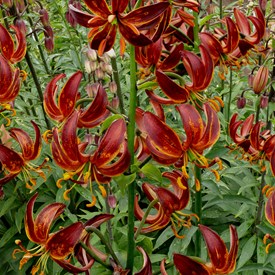Types of Lilies
Lots of plants are labeled "lilies," such as day lilies, calla lilies, lily-of-the-valley and others. True lilies are perennial plants, members of the genus Lilium and emerge from a bulb that is composed of fleshy scales. They produce erect leafy stems from under two feet to over six feet tall, topped with terminal flowers which vary in shape from massive trumpets to very small bell-shaped flowers. Lily flowers come in many colors and color combinations (except blue) but typically have six tepals and six anthers.
-
SPECIES Lilies

Species 'Lilium Henryi' Species lilies are ones that grow naturally in different parts of North America, Europe and Asia. Species lilies are the original source for all hybrids. Some may be acclimated to local gardens while others are more difficult to grow outside their natural habitat. Lilium longiflorum is an example of a species lily, native to Taiwan and Ryukyu Islands, that has been adapted by growers as the Easter Lily.
-
ASIATIC Hybrids

Asiatic 'Heartstrings' The species from which these lilies were derived came from Asia. Most are early bloomers (June to early July) and come in the broadest color range of any lily group. Colors range from shades of red, yellow and orange to more delicate hues of whites, creams and pinks. Flowers may be upfacing, outfacing or downfacing.
-
MARTAGON Hybrids

Martagon 'Arabian Knight' This is a less common type of lily on the East Coast but is becoming more widely grown. It is characterized by a whorl of leaves and many little turkscap blossoms. It can take these lilies a year to adjust to a garden environment, but once adjusted, they will bloom for years if happy in their location. Martagons are the earliest lilies to bloom and do well with some shade. Yellow, pink, lavender, light orange and very deep dark red are the colors frequently seen and often with speckles and freckles on the blooms.
-
TRUMPET/AURELIAN Hybrids

Trumpet 'Summer Palace' These lilies have tall pyramids of bloom in glistening whites, golds, yellow, chartreuse, pink, plum and apricot with the reverse side of the bloom in colors of brown, purple or green. Some of the trumpets are pendant like bells, others have a wide flare in a shallow bowl shape. Generally trumpets are easy to grow and are hardy in the garden and bloom after most Asiatics.
-
ORIENTAL Hybrids

Oriental 'Stargazer' Orientals are not among the easiest lilies to grow but are noted for their showy flowers and fragrance. These lilies have raised bumps, called papillae, on the blooms. Often available as a potted plant from nurseries, these beauties do not enjoy our hot, humid summers and may fade out after two to three years if planted in the garden. These lilies are very popular with the Brides, especially 'Stargazer' and 'Casablanca.'
-
LA/LO/OA Lilies

Oriental/Asiatic 'Avalon Sunset' An LA is a cross between L. Longiflorum (the Easter Lily) with Asiatic varieties. This lily is sturdier than most Asiatics and has larger flowers and a slight fragrance. Generally the substance of the flower is thicker than most Asiatics; the blooms tend to be crowded on the stem. In an LO Lily, longiflorum is crossed with an Oriental. These lilies have large, very showy blooms but may be more difficult to grow in hot, humid weather. An OA lily is another cross between an Oriental and Asiatic.
-
OT Hybrids

Oriental/Trumpet 'Macizo' These lilies are a cross between the Oriental and Trumpet lilies. The flowers are as showy as an Oriental bloom but derive their height and hardiness from the Trumpet. New and exciting colors have resulted from this cross. Popular selections from this group include Conca d'or, Robina, Shocking and many others. Sometimes marketed as "Lily Trees" due to heights reaching 5-7', the large stalks are not woody and will die back at the end of the season.
-
DOUBLE Lilies

Double Lily 'Lotus Joy' "Double" lilies have a center of extra petals instead of pistil and stamen and are pollen-free. They are sometimes called "rose lilies," and are known for their soft fragrance and long vase life. Double lilies are commonly Asiatics or Orientals.
Photos courtesy of The Lily Garden.
